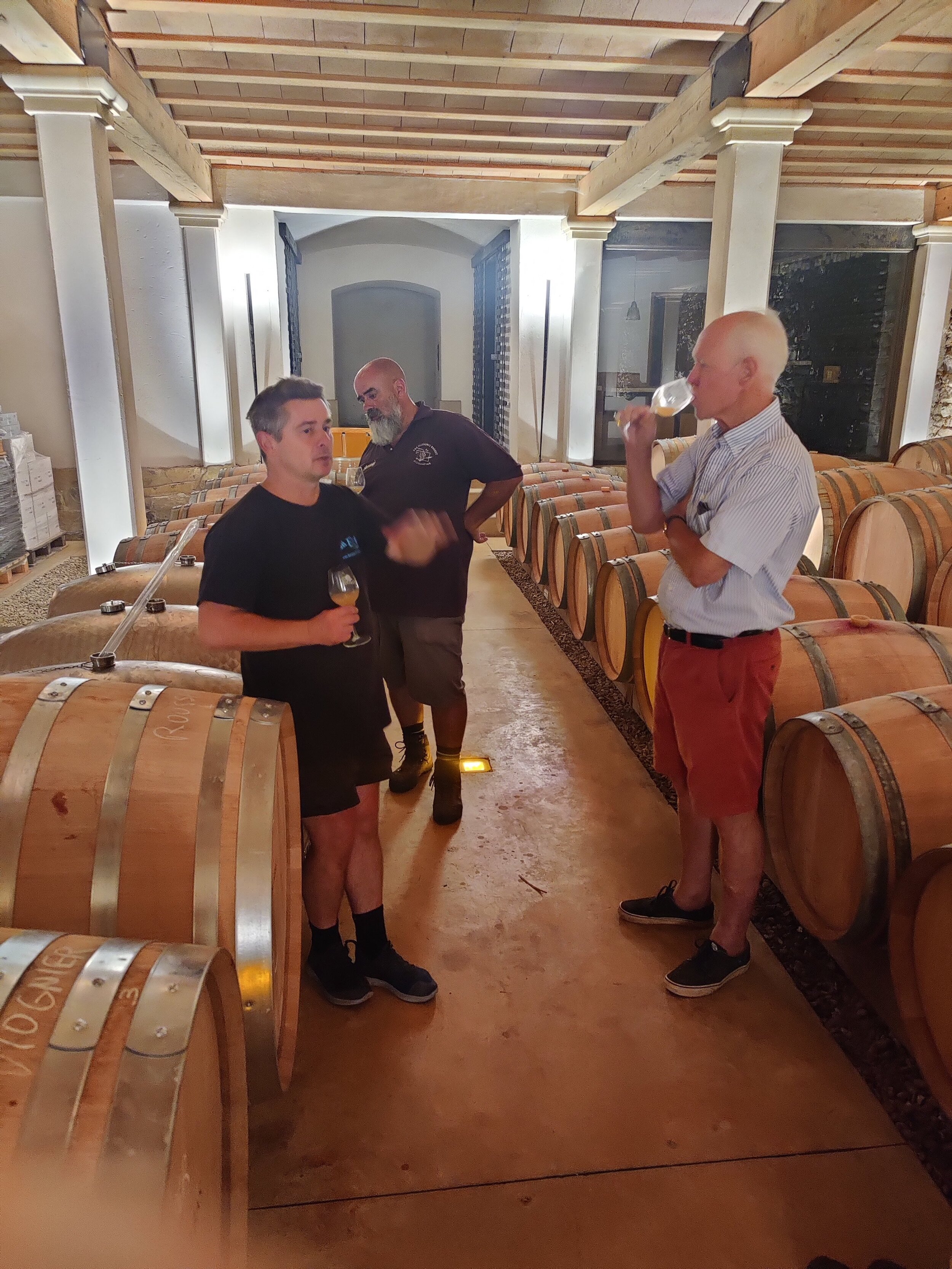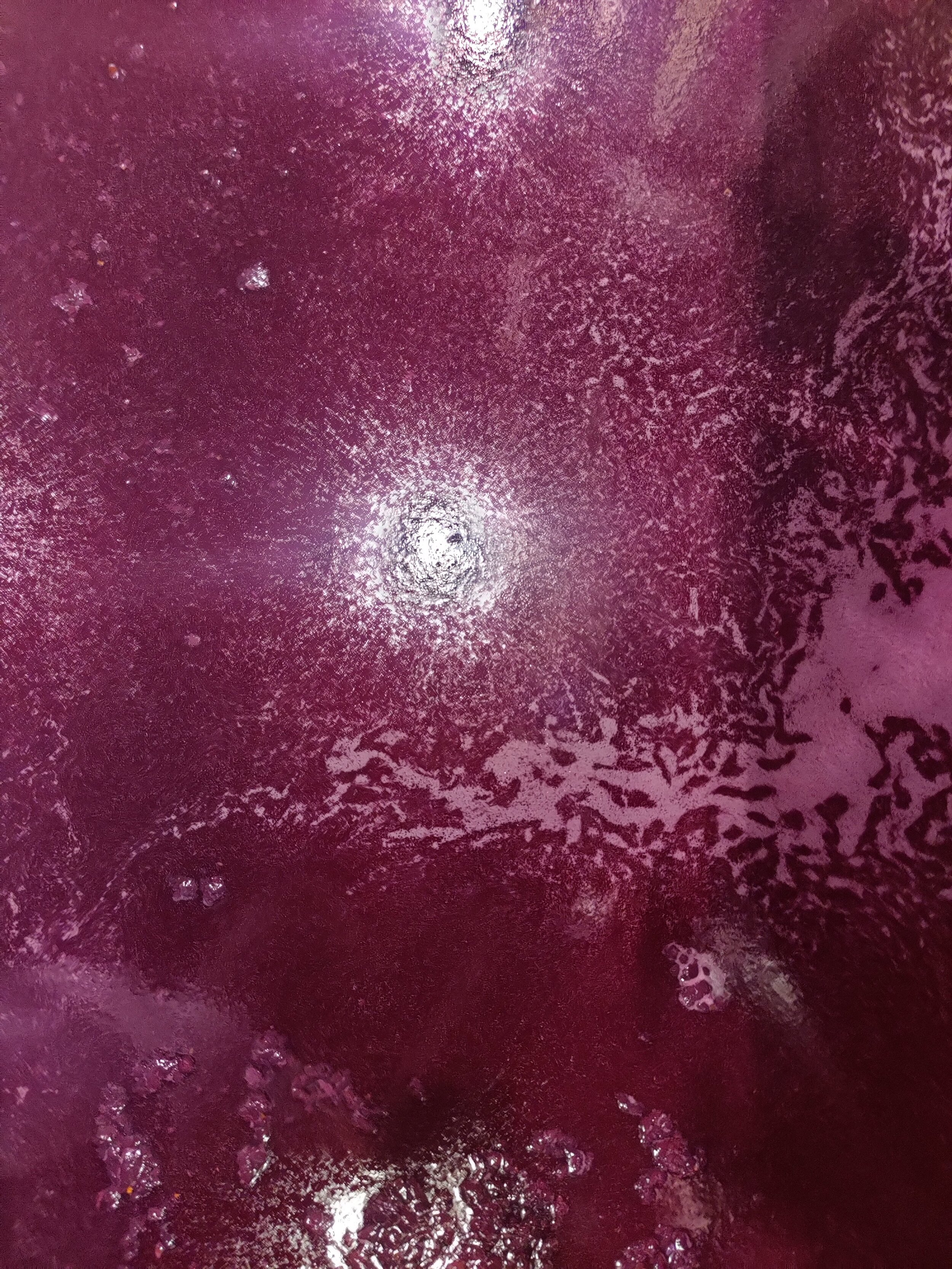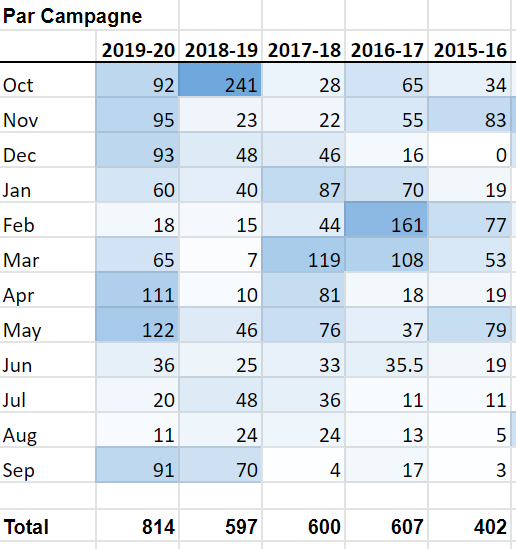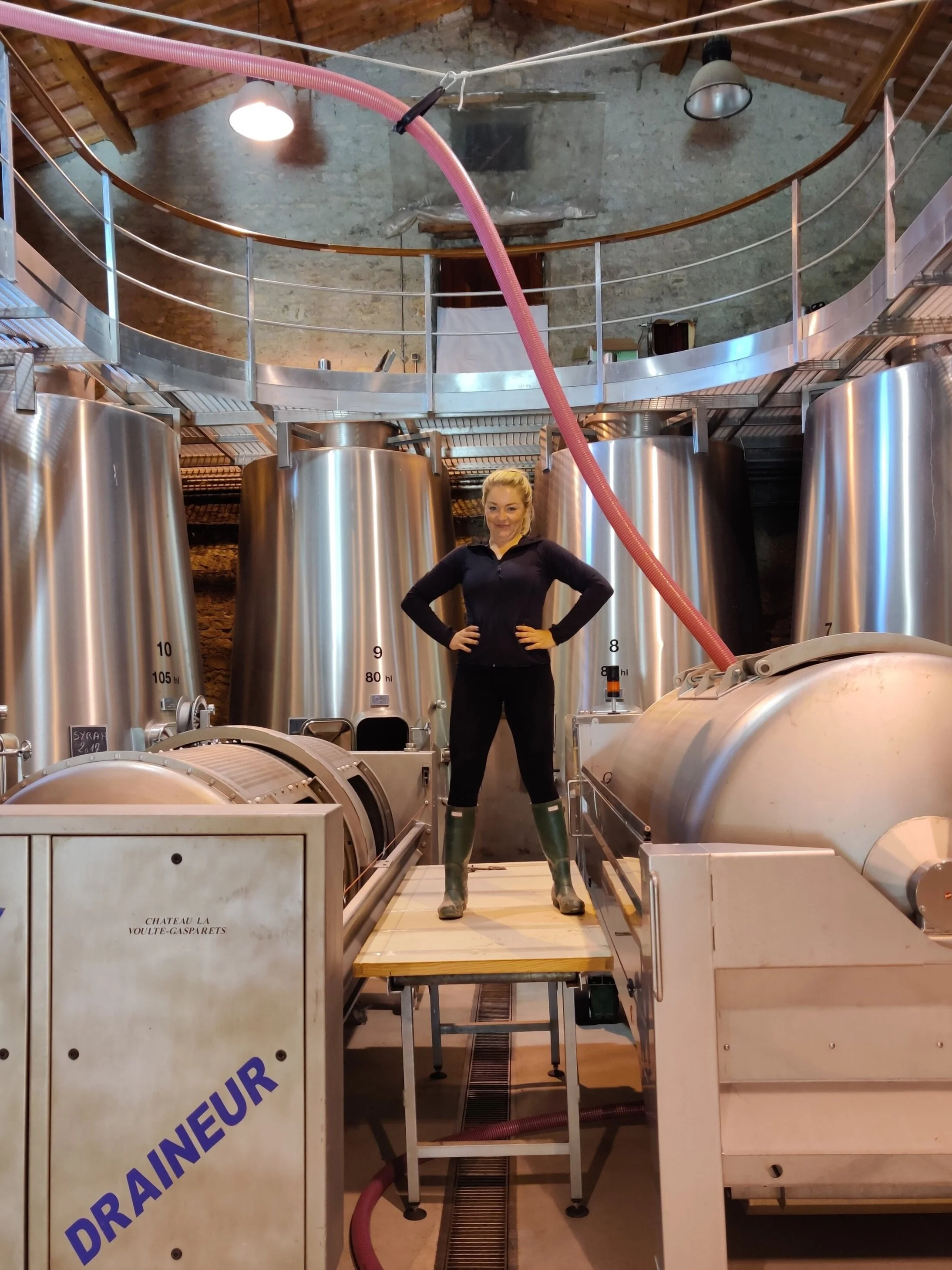“....A delightful and promising harvest after a challenging year on all dimensions..Une belle vendange sans surprises, apres une année difficile sur tous les fronts....”



....
While the global pandemic pursues its inexorable advance, the effects on the wine industry will be felt for many years to come. Combined with oversupply and stubbornly high stock levels in 2018 and 2019, some regions have been forced to artificially curtail yields to try to balance supply and demand, and more poignantly, many vineyards, their tanks and barrels still full of unsold wine, have been struggling to find empty containers for the incoming grapes.
The 2020 harvest is looking plentiful, precocious and healthy in most parts, though 2021 is still clouded in uncertainty for the final product and the livelihoods of all those involved. Against that challenging backdrop, the Minervois harvest looks to be a very good one, at least for those who managed to get through the wet start of the season without disease, and to bring in their grapes before the rains came in mid September.
We concluded last year with plentiful wine tanks, but with the worry was that water tables were not replenished after a warm and dry spring / summer 2019. Even though rainfall through the September 2018 to August 2019 period has been remarkably consistent at approximately 600 mm of rain over three years, the April to August was dry relative to other years.
The Rain Gods smiled on us this season, especially in the winter-spring of 2019-20. The last months of 2019 saw almost 100 mm of rain per month. And in particular, April - May 2020 received 233 mm (versus 56 mm same period in 2019). However, be careful what you wish for! Suddenly, tractors couldn't get out and things looked dire. Compound that with rising temperatures, budding accelerated - and also threatening an onset of fungal diseases under a combination of warmth and moisture. Earlier smiles on our faces turned to consternation, at the prospect of waves of mildew.
..
Alors que la pandémie poursuit sa progression inexorable, ses effets sur la filière viticole se feront sentir pendant de nombreuses années. Conjugués à une offre excédentaire et à des niveaux de stocks obstinément élevés en 2018 et 2019, certaines régions ont été contraintes de réduire artificiellement les rendements pour tenter d'équilibrer l'offre et la demande. Plus grave encore, de nombreux vignobles, dont les cuves et barriques étaient encore pleines de vin invendu, ont dû se battre pour trouver la place pour les raisins qui arrivaient.
La récolte 2020 s'annonce abondante, précoce et saine dans la plupart des régions, bien que pour l'année 2021 l'incertitude règne encore quant au produit final et aux moyens de subsistance de toutes les personnes au sein de l’industrie. Dans ce contexte difficile, la récolte du Minervois s'annonce très bonne, du moins pour ceux qui ont réussi à passer le début de saison humide sans maladie, et à rentrer leurs raisins avant les pluies de mi-septembre.
Nous avions terminé la saison précédente avec des cuves pleine, mais avec l'inquiétude que les nappes phréatiques ne soient pas reconstituées après un printemps et été 2019 chauds et secs. Même si les précipitations de septembre 2018 à août 2019 ont été remarquablement constantes, avec environ 600 mm de pluie par an, la période d'avril à août a été sèche par rapport aux autres années.
....
H2O
....a decent jump to replenish the water reserves..Une pluviométrie très bonne en 2019-20 pour restaurer les nappes phréatiques ....
H2O detail
....even though we had hot and dry conditions through the summer, there was still more rain spread across Apr-Aug..Bien que très chaud et sec cet été, la pluviométrie plutôt bonne entre avril et aout....
....
It was only the efforts of Arnaud, our resident oenologue, who only had to sniff a modicum of potential mildew and he was out in the fields, working to keep the fungus at bay within the limits of organic practices - and was largely successful. With mildew, one cannot wait until Monday morning and take the weekend off, allowing for the fungus to be carried in the wind/splashed back onto the vines and install itself. It's a formula for disaster, as it spreads so quickly. Several mornings, I was awakened early by the sound of his tractor, as soon as the soil became hard enough, but sunk back under the covers, reassured by his efforts. In addition, careful canopy management in recent years has been successful in reducing leaf bunching, which can exacerbate the risk.
Consequently, we escaped the worst of any damage to the vines during this fragile period, when vines are most susceptible to permanent damage and loss of fruit, especially Grenache, if it suffers from “coulure”. Once the budding translated into fruit, worries partly went away but not entirely, as the period of flowering ("floraison") and of fruit set ("nouaison") is always a delicate one, with the latter being quite short. We were watching the meteo with concern towards the end of May, as temperatures dropped. Frost at this delicate time can also be disastrous, the danger from which does not disappear until the end of May. Temperatures did drop, but not to freezing, the breezes up the central part of the property keeping Jack Frost away.
To be honest, autumn of 2019 and the first 5 months of 2020 were difficult to work, whether the manual pruning or tractor work. The outlook was worrying and essential work was delayed. Prayers were uttered for a return to more normal weather patterns.
Having exited May with no damage, sighs of relief were now audible and we relished the possibility of a good harvest under blue skies and above-average temperatures. With the firming of the bunch of grapes into June, risk of disease weakens. Hail would become the next potential concern but storm activity was remote during June and July, and passed nearby in early September. The move into the ripening phase continued, with both fattening and colouring ("veraison") progressing without much concern and indications were also for an early harvest. The weather unfolded into one of uninterrupted warmth and dryness, laying the foundation for quality. The earlier rains in April - May, while disruptive to work at the time, had a silver lining and replenished the water table, allowing vines to surmount the dry summer months without any unwanted hydric stress. But they also gave free rein to growth of weeds, requiring numerous passages of our faithful 'intercept' (mechanical weeding machine), chemical control being highly regulated under our organic protocol.
"Le mois d'Août fait le Mou" (‘August makes the Must’, as goes the saying). A relatively quiet month for wine makers, apart from some weeding and trimming of the vines ("rognage") where excessive growth might be caught up by tractors and/or harvesting machines, causing damage to the plants. The analysis of progress in mid-August showed:
maturing was one week in advance on average, with white varieties up to two weeks ahead of 2019
a steady acceleration in maturation, but under conditions of warm days and cool nights
healthy fruit across the board and no water stress
higher acidity than 2019
overall lower alcohol potential than 2019
End of August was blessed with some 10 mm of rain, enough to moisten the soil and steady the maturation but not so much as to bloat the grapes and risk diseases that can ensue if the grapes burst. Maturing of both the Syrah and Grenache, our predominant red grapes, was stabilised for September, a month of cool nights and slowly descending day temperatures.
Harvesting started on the 20th of August with the whites; Roussanne first, then the Vermentino and Viognier. Machine picking was conducted very early in the mornings, aiming for 4am starts, while the grapes were still cool to prevent premature oxidation during transport. The Vermentino has proven to be a pillar of our whites, adjusting well to the hot, dry conditions of summer 2020. Thought to originate in Sardinia, which regularly has a water shortage in summer, the varietal moved up into Corsica and is increasingly popular now in the south of France. Viognier, traditionally grown in the Rhone valley, is well known for its powerful flower and fruit aromas. Our whites yielded some 35% less than 2019, partly due to our approach to reworking the canopy and pruning, but manifested fruitiness, pronounced aromas and higher acidity. We've increased our use of barrels for fermentation and ageing for some of our whites again this year. With 10 (Minervois) up to 32 (Pays d’Oc) different varieties of white grape and less pressure for AOP/IGP type regulations, whites are generating increasing interest as an excellent 'value for money' proposition in our region. Expect to see more variety in our whites in coming years from us.
The whites were followed by the Grenache for our rosé, picked early in the morning too, followed by the Mourvèdre. Pressed upon arrival, the fruit juice was cooled further to accelerate deposit of any bourbes before fermentation. Both whites and rosé are fermented between 15-20 C, cooler fermentation than for the reds but which better maintains acidity and fruitiness. It takes longer to complete but the wait is worth it in favourable years!
Grenache for the reds was followed 10 days later by the Syrah, our most important varietal, on the 14th of September. The 2019 Syrah suffered from some 'fletrissement' (wilting) from lack of water. But not the 2020's! Healthy, firm grapes with no 'amertume' (bitterness). High quality all round, notably our fields of older vines with deeper roots. The 2020 Grenache for the reds, largely from a single 2.5 hectare field, displayed higher yields than in 2019, accompanied by a concentration of maturity and fruitiness, better than expected.
Finally, the Carignan (only some 4-5% of our production now, versus some 80% when I arrived in 2001) displayed a balance of fruitiness and acidity, with firmness of feel.
We finished the harvest on the 23th of September, just a day before the rains re-appeared and with distinctly cooler weather. Shorts went back in the drawers! Arnaud, our oenologue, summarises 2020 as being "a year of fruity wines, with good structure and a zippy freshness to them. Wines that can be drunk soon after bottling but will mature well in cellars". All our consternation back in April/May was replaced in August/September with recognition that full water tables and warm, dry weather would produce a quality harvest. So, thank you Mother Nature!
Graham and the St. Jacques team
..
Les Dieux de la Pluie nous ont souri cette saison, surtout en hiver-printemps 2019-20. Les derniers mois de 2019 ont connu près de 100 mm de pluie par mois. Et en particulier, avril à mai 2020, 233 mm (contre 56 mm à la même période en 2019). Cependant, il faut se méfier de ses aspirations ! Soudain, les tracteurs ne pouvaient plus sortir et la semblait désastreuse. De plus, avec la hausse des températures, le bourgeonnement s'est accéléré et a augmenté le risque d'apparition de maladies telles que le mildiou sous l'effet conjugué de la chaleur et de l'humidité. Les sourires se sont transformés en consternation, à la perspective de vagues de moisissure.
Ce n'est que grâce aux efforts de notre œnologue Arnaud pour maintenir les maladies à distance dans les limites des pratiques biologiques - et il a largement réussi. Avec le mildiou, on ne peut pas profiter de son weekend et attendre le lundi matin, puisqu'entre temps le champignon aura pu être transporté par le vent sur les vignes avoisinantes. C'est le désastre assuré, car il se propage si rapidement. En outre, notre gestion prudente de la couverture végétale au cours des dernières années a permis de réduire le tassement des feuilles, qui peut aggraver le risque.
Par conséquent, nous avons échappé aux pires dégâts sur les vignes pendant cette période décisive, où les vignes sont les plus susceptibles de subir des dommages permanents et de perdre du fruit, en particulier le Grenache, s'il souffre de "coulure". Une fois le bourgeonnement en fruit, les difficultés ont en partie disparu, mais pas entièrement, car la période de floraison et de nouaison est toujours délicate, cette dernière étant assez courte. Nous avons observé la météo avec inquiétude vers la fin du mois de mai, alors que les températures baissaient. Le gel à cette période peut être désastreux, et le danger ne disparaît pas avant la fin du mois de mai. Les températures ont effectivement baissé, mais pas au point de geler, la brise qui souffle sur la propriété minimisant le risque.
Pour être honnête, l'automne 2019 et les 5 premiers mois de 2020 ont été difficiles, que ce soit la taille manuelle ou le travail au tracteur. Les perspectives étaient inquiétantes et des travaux essentiels ont été retardés. Nous avons prié pour un retour à des conditions météorologiques plus normales.
Ayant traversé le mois de mai sans dommage, nous avons poussé des soupirs de soulagement et savouré la possibilité d'une bonne récolte sous un ciel bleu et des températures agréables. Avec le raffermissement de la grappe de raisin en juin, les risques de maladie s'atténuent. La grêle sera le prochain souci potentiel, mais l'activité orageuse était lointaine en juin et juillet, et nous a épargnés de justesse début septembre. Le passage à la phase de maturation s'est poursuivi, l'engraissement et la véraison progressant sans trop d'inquiétude et les indicateurs laissaient également présager une récolte précoce. Les pluies précoces d'avril-mai, bien que perturbant le travail à l'époque, ont eu un effet positif et ont reconstitué la nappe phréatique, permettant aux vignes de surmonter les mois d'été secs sans stress hydrique indésirable. Mais elles ont également donné libre cours à la croissance des mauvaises herbes, nécessitant de nombreux passages de notre fidèle "intercept" mécanique, la lutte chimique étant très réglementée dans le cadre de notre protocole biologique.
“Le mois d'Août fait le Mou”. Un mois relativement calme pour les vignerons, à l'exception de désherbage et d'une taille des vignes ("rognage"). Les analyses réalisés à la mi-août ont montré que la maturation était en moyenne une semaine en avance, les variétés blanches jusqu'à deux semaines en avance sur 2019, une accélération constante de la maturation dans le temps, mais dans des conditions de journées chaudes et de nuits fraîches, avec des fruits sains et pas de stress hydrique, une bonne acidité, et un potentiel d'alcool globalement plus faible qu'en 2019.
La fin du mois d'août a été bénie par quelque 10 mm de pluie, assez pour humidifier le sol et stabiliser la maturation, mais pas au point de faire gonfler les raisins et de risquer les maladies qui peuvent s'ensuivre si les raisins éclatent. La maturation de la Syrah et du Grenache, nos raisins rouges prédominants, a été stabilisée début septembre, avec un mois de nuits fraîches et de températures tempérées.
Les vendanges ont commencé le 20 août avec les blancs ; la Roussanne d'abord, puis le Vermentino et le Viognier. Les vendanges ont été effectuées très tôt, avec pour objectif de commencer à 4 heures du matin, alors que les raisins sont encore frais pour éviter une oxydation prématurée pendant le transport. Le Vermentino s'est révélé être un pilier de nos blancs, s'adaptant bien aux conditions chaudes et sèches de l'été. Probablement originaire de la Sardaigne, qui connaît régulièrement des pénuries d'eau en été, le cépage s'est déplacé vers la Corse et est de plus en plus populaire dans le Sud de la France. Le viognier, traditionnellement cultivé dans la vallée du Rhône, est bien connu pour ses puissants arômes de fleurs et de fruits. Nos blancs ont donné un rendement inférieur de 35% par rapport à celui de 2019, en partie en raison de notre approche de remaniement de la canopée et de la taille, mais ils se sont manifestés fruités, avec des arômes très agréables et une acidité plus élevée. Cette année encore, nous avons augmenté l'utilisation de barriques pour la fermentation et le vieillissement de certains de nos blancs. Avec 10 (Minervois) à 32 (Pays d'Oc) cépages blancs différents, les blancs se développent de plus en plus dans notre région avec un excellent rapport qualité-prix. Attendez-vous à voir plus de variété dans nos blancs dans les années à venir!
Les blancs ont été suivis par le Grenache pour notre rosé, vendangé lui aussi tôt le matin, puis par le Mourvèdre. Pressé à l'arrivée, le jus de fruit a été refroidi pour accélérer le dépôt des bourbes avant la fermentation. Les blancs et les rosés sont fermentés entre 15 et 20 C, une fermentation plus froide que pour les rouges mais qui maintient mieux l'acidité et le fruit. Elle est plus longue à terminer mais l'attente en vaut la peine!
Après le Grenache pour les rouges, c'était, 10 jours plus tard, le tour de la Syrah, notre cépage le plus important, le 14 septembre. La Syrah de 2019 a souffert d'un certain "fletrissement" dû au manque d'eau. Mais pas celui de 2020 ! Des raisins sains, fermes et sans amertume. Une grande qualité dans tous les domaines, notamment dans nos parcelles de vieilles vignes aux racines plus profondes. Le Grenache 2020 pour les rouges, provenant en grande partie d'un seul champ de 2,5 hectares, a affiché des rendements plus élevés qu'en 2019, accompagnés d'une concentration de maturité et de fruit meilleure que prévu.
Nous avons terminé les vendanges le 23 septembre, juste avant que les pluies ne reviennent. Les shorts sont retournés dans les tiroirs ! Arnaud, notre œnologue, résume 2020 comme étant "une année de vins fruités, avec une bonne structure et une excellente fraîcheur. Des vins qui peuvent être bus peu après la mise en bouteille mais qui mûriront bien en cave". Notre consternation d'avril/mai a été remplacée en août/septembre par la satisfaction que les nappes phréatiques se remplissent, et un temps chaud et sec produiraient une récolte de qualité. Alors, merci à Dame Nature !
Graham, et l'équipe St. Jacques
....














